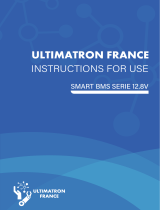
1
EN NL FR DE ES SE
1. General Description
A simple and low cost alternative to the VE.Bus BMS
The smallBMS can replace the VE.Bus BMS in several applications. It is however not suitable for use with VE.Bus MultiPlus and
Quattro inverter/chargers: it has no VE.Bus interface.
The smallBMS is intended for use with Victron Smart LiFePo4 batteries with M8 circular connectors.
The smallBMS has three outputs, similar to the VE.Bus.BMS.
Load Disconnect output
The Load output is normally high and becomes free floating in case of imminent cell under voltage voltage (default 2,8V/cell,
adjustable on the battery between 2,6V and 2,8V per cell). Maximum current: 1A. The Load output is not short-circuit protected.
The Load output can be used to control:
A high current relay or contactor.
The remote on/off input of a BatteryProtect, inverter or DC-DC converter or other loads.
(a non inverting or inverting on/off cable may be required, please consult the manual)
Pre-alarm output
The pre-alarm output is normally free floating and becomes high in case of imminent cell under voltage (default 3,1V/cell,
adjustable on the battery between 2,85V and 3,15V per cell). Maximum current: 1A (not short circuit protected).
The minimum delay between pre-alarm and load disconnect is 30 seconds.
Charge disconnect output
The Charger output is normally high and becomes free floating in case of imminent cell over voltage or over temperature.
Maximum current: 10mA.
The Charger output is not suitable to power an inductive load such as a relay coil.
The Charger output can be used to control:
• The remote on/off of a charger.
• A Cyrix-Li-Charge relay.
• A Cyrix-Li-ct Battery Combiner.
System on/off input
The system on/off input controls both outputs. When off, both outputs will be free floating so that loads and chargers are turned
off.
The System on/off consists of two terminals: Remote L and Remote H.
A remote on/off switch or relay contact can be connected between L and H.
Alternatively, terminal H can be switched to battery plus, or terminal L can be switched to battery minus.
Protects 12V, 24V and 48V systems
Operating voltage range: 8 to 70V DC.
LED indicators
• Load ON (blue): Load output high (cell voltage >2.8V, adjustable on the battery).
• Temp or OVP (red): Charger output free floating (due to cell over temperature (>50°C), cell under temperature (<5 °C)
or cell over voltage).
2. Safety instructions
Installation must strictly follow the national safety regulations in compliance with the enclosure, installation, creepage, clearance,
casualty, markings and segregation requirements of the end-use application. Installation must be performed by qualified and
trained installers only. Switch off the system and check for hazardous voltages before altering any connection.
1. Do not open the Lithium Ion Battery.
2. Do not discharge a new Lithium Ion Battery before it has been fully charged first.
3. Charge only within the specified limits.
4. Do not mount the Lithium Ion Battery upside down.
5. Check if the Li-Ion battery has been damaged during transport.
6.
3. Things to consider
3.1 Important warning
Li-ion batteries are expensive and can be damaged due to over discharge or over charge.
Damage due to over discharge can occur if small loads (such as: alarm systems, relays, standby current of certain loads, back
current drain of battery chargers or charge regulators) slowly discharge the battery when the system is not in use.
In case of any doubt about possible residual current draw, isolate the battery by opening the battery switch, pulling the battery
fuse(s) or disconnecting the battery plus when the system is not in use.
A residual discharge current is especially dangerous if the system has been discharged completely and a low cell
voltage shutdown has occurred. After shutdown due to low cell voltage, a capacity reserve of approximately 1Ah per
100Ah battery capacity is left in the battery. The battery will be damaged if the remaining capacity reserve is drawn
from the battery. A residual current of 10mA for example may damage a 200Ah battery if the system is left in
discharged state during more than 8 days.









